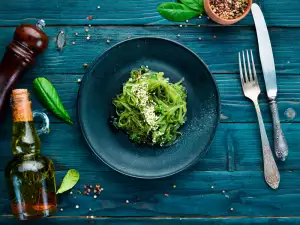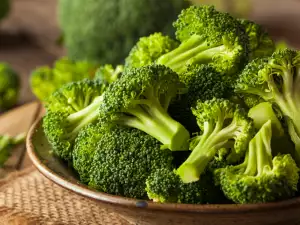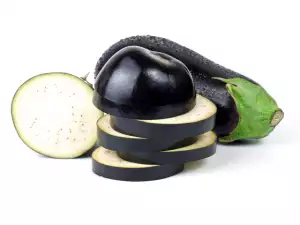Deeply valued for its bright purple color, glossy skin and unique flavor and texture, aubergines are available in stores year round, but the best quality from early August to late October, when their season is.
Aubergines belong to the dog grape family, which includes tomatoes, peppers and potatoes, and these grow in a manner similar to tomatoes. Although the above vegetables vary greatly in taste and appearance, one can certainly describe the fascinating bitter taste and spongy texture of aubergines. In many recipes, it is used as an additive in balancing the strong surrounding flavors.
Different types of aubergines can have lavender color, be green, orange or yellow-white and vary in size and shape - such as the size of a small tomato to those resembling a large zucchini.
History of aubergines
Ancient ancestors of aubergines are grown in India, but they were first cultivated in China as early as the fifth century BC and in the Middle Ages, they were introduced in Africa and later - Italy - a country which has long been associated to them. Today, Turkey, Italy, Egypt, China and Japan are among the leading countries growing this vegetable.

Although it has a long and rich history, aubergines were not always with a good name. As a result of the sour taste and bitter qualities - aubergines received undeserved fame as being capable of causing insanity, leprosy and cancer. By the 18th century, when new varieties of this vegetable developed, it remains at an unenviable position in the rankings. Today, however aubergines take pride of place in the cuisine of many European countries, including Italy, Greece, Turkey and France.
Composition of aubergines
Aubergines are poor in hydrocarbons, but very rich in various useful minerals: potassium, calcium, magnesium, manganese, iron, and pectic substances. Aubergines also contain dietary fiber, folic acid, copper, vitamin C and vitamin K, B6 and PP. The bitter taste is due aubergines containing these oils.
In 100 grams of aubergines, you find 1.4 g protein, 0.2 g fat, 4.0 g carbohydrates, 92.8 ml water, 25 calories, 1.1 g fiber.
Types of aubergines
The more popular types of aubergines known to man are five in number.
American eggplant - elongated, colored in dark purple;
Italian aubergines - it is relatively smaller than other types of eggplant, but in contrast, has a gentle flesh and skin and a much better taste;
Sicilian aubergines - irregularly shaped, large and round, with a very thin skin and a slightly sweet taste;
Oriental aubergine - stretched thin and light, it has a thin skin and significantly fewer seeds than its cousins;
White aubergines - a thick skin and a harder core.

Selection and storage of aubergines
Choose aubergines that are firm and heavy for their size. Their skin should be smooth and soft, and the color bright. Both ends of the aubergine should be green.
Although solid, aubergines are actually quite gentle and care should be taken to store them. They are sensitive to cold and heat. Therefore, the most appropriate for them storage temperature is around 10 degrees Celsius.
Place the aubergines unwashed in plastic bags and store them in the refrigerator where they will keep fresh for a few days.
Cooking aubergines
- When cutting the aubergine, use a stainless steel blade, since the use of carbon steel will lead to blackening of the knife.
- First wash the aubergine, then remove its edges.
- To soften the bitter taste, chop the salted eggplant and allow to stand at a slight incline for 30 minutes. This process will lead to their relative dehydration, which would make it less capable of absorbing fat.
- Aubergines can be fried, baked or prepared by steaming. If you cook a whole aubergine, first Pierce in several places with a fork to allow steam to escape through the holes. If you cook in the oven, bake it at 180 degrees for 15 to 25 minutes depending on the size of the pieces. When frying, use a small amount of oil because they have a porous structure through which they can take in a considerable amount of fat, which makes it a very unhealthy product.
Aubergines are used in many dishes. They are one of the most commonly used vegetables in Mediterranean cuisine. Find them in salads, main dishes with meat and other vegetables. The taste is complemented very well by garlic, olive oil, lemon juice.
Benefits of aubergines
Aubergines are rich in vitamins, minerals and essential phytonutrients that have antioxidant benefits.

- Aubergines are brain food. There are many studies focused on the phytonutrient antitsianin-called nasunin, which is located in aubergines. It is a potent antioxidant, purifying free radicals and protecting cell membranes, thus contributing to the smooth functioning of our brain.
- Aubergines are rich in antioxidant phenolic compounds. Aubergines are a rich source of phenolic compounds, which act as antioxidants. Chlorogenic acid found in such vegetables has antiviral activity and prevents the occurrence of changes (cancer induction).
- Aubergines are welcomed by our cardiovascular health system and protect us from free radicals.
Thanks to nasunina and other phytonutrients found in aubergines, these vegetables help reduce high levels of cholesterol in the blood, and arterial walls, thus improving blood flow.
Dangers of aubergines
Aubergines are one of the few foods containing oxilates - natural substances found in plants, animals and humans. When they become too concentrated in body fluids, they can crystallize and cause health problems. For this reason people that have problems with your kidneys or gall, must be careful with aubergines.














Comments